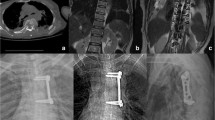Abstract
Purpose
This study aimed at discussing the relevance of the type B3 fracture of the new AOSpine classification.
Methods
Hyperextension fractures of the spine are rare in the general population, but common in the ankylotic spine. We present a case of a severe spinal fracture with concomitant esophageal rupture, which was diagnosed early and could be treated during the initial trauma care.
Results
The spinal column was stabilized using a percutaneous technique after which the perforated esophagus was sutured through a thoracotomy. The spinal injury was classified a type B3 fracture using the new AOSpine classification.
Conclusion
The B3 typification raised a lot of discussion during the development of the new classification system and may be controversial. This case, however, nicely illustrates the relevance of an intact posterior hinge as compared to C-type injuries where complete dissociation is present with inherent spinal cord damage.




Similar content being viewed by others
References
Westerveld LA, Verlaan JJ, Oner FC (2009) Spinal fractures in patients with ankylosing spinal disorders: a systematic review of the literature on treatment, neurological status and complications. Eur Spine J 18:145–156
Westerveld LA, van Bemmel JC, Dhert WJA, Oner FC, Verlaan JJ (2014) Clinical outcome after traumatic spinal fractures in patients with ankylosing spinal disorders compared with control patients. Spine J 14:729–740
Kiss C, Szilágyi M, Paksy A, Poór G (2002) Risk factors for diffuse idiopathic skeletal hyperostosis: a case–control study. Rheumatology (Oxford) 41:27–30
Denko CW, Malemud CJ (2006) Body mass index and blood glucose: correlations with serum insulin, growth hormone, and insulin-like growth factor-1 levels in patients with diffuse idiopathic skeletal hyperostosis (DISH). Rheumatol Int 26:292–297
Weinfeld RM, Olson PN, Maki DD, Griffiths HJ (1997) The prevalence of diffuse idiopathic skeletal hyperostosis (DISH) in two large American Midwest metropolitan hospital populations. Skeletal Radiol 26:222–225
Kim S-K et al (2004) The prevalence of diffuse idiopathic skeletal hyperostosis in Korea. J Rheumatol 31:2032–2035
Smyth S, Heron A (2006) Diabetes and obesity: the twin epidemics. Nat Med 12:75–80
World Health Organization (2000) Obesity: preventing and managing the global epidemic. Report of a WHO consultation. World Health Organ. Tech. Rep. Ser. 894:i–xii, 1–253
Magerl F, Aebi M, Gertzbein SD, Harms J, Nazarian S (1994) A comprehensive classification of thoracic and lumbar injuries. Eur Spine J 3:184–201
Reinhold M et al (2013) AO spine injury classification system: a revision proposal for the thoracic and lumbar spine. Eur Spine J 22:2184–2201
Chapman JR, Agel J, Jurkovich GJ, Bellabarba C (2008) Thoracolumbar flexion-distraction injuries: associated morbidity and neurological outcomes. Spine (Phila Pa 1976) 33:648–657
Nakai S, Yoshizawa H, Kobayashi S, Miyachi M (1998) Esophageal injury secondary to thoracic spinal trauma: the need for early diagnosis and aggressive surgical treatment. J Trauma 44:1086–1089
Cherveniakov A, Cherveniakov P (1992) Surgical treatment of acute purulent mediastinitis. Eur J Cardiothorac Surg 6:407–410 (discussion 411)
Uhrenholt L et al (2011) Esophageal injury in fatal rear-impact collisions. Forensic Sci Int 206:e52–e57
Tjardes T, Wafaizadeh A, Steinhausen E, Krakamp B, Bouillon B (2009) Extension injury of the thoracic spine with rupture of the oesophagus and successful conservative therapy of concomitant mediastinitis. Eur Spine J 18(Suppl 2):240–244
Author information
Authors and Affiliations
Corresponding author
Ethics declarations
Conflict of interest
None of the authors has any potential conflict of interest.
Rights and permissions
About this article
Cite this article
Groen, F.R.J., Delawi, D., Kruyt, M.C. et al. Extension type fracture of the ankylotic thoracic spine with gross displacement causing esophageal rupture. Eur Spine J 25 (Suppl 1), 183–187 (2016). https://doi.org/10.1007/s00586-015-4315-1
Received:
Revised:
Accepted:
Published:
Issue Date:
DOI: https://doi.org/10.1007/s00586-015-4315-1




